#burmese history
Explore tagged Tumblr posts
Text
PANHTWAR // QUEEN OF BEIKTHANO
“She was the legendary queen regnant of Beikthano, the ancient city of the Pyu Kingdom. She was considered to be a strong, spiritual lady of war and fame. Queen Panhtwar became a heroine figure in Burmese culture, gracing the bedtime stories of Burmese children since their early years.”
2 notes
·
View notes
Text
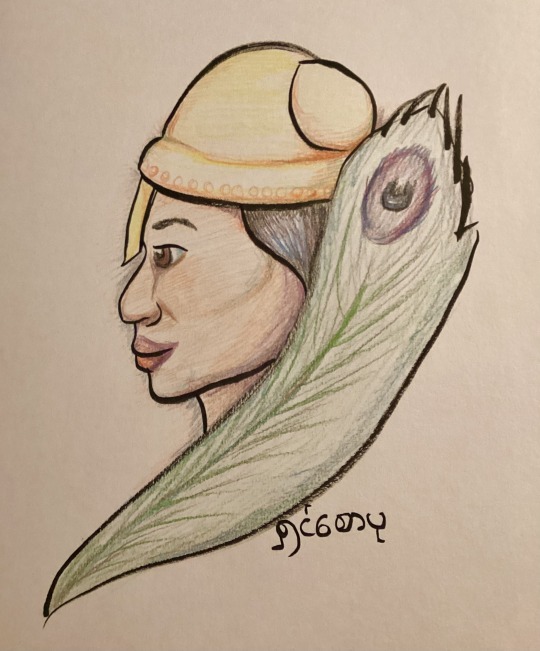
Day 8: Shin Sawbu!
Shin Sawbu was given the name Viharadevi, “Queen of the Monastary,” by her father, King Rahazadarit of Hanthawaddy Pegu, a kingdom in what is now Myanmar/Burma. It would prove an apt name. She was married to a royal cousin, with whom she had three children, but was widowed by twenty-five. After her father’s death, her brothers battled each other for the throne, one inviting the king of neighboring Ava to intervene. As part of the eventual peace settlement, Shin Sawbu was given to said king in marriage and forced to leave her children behind in Pegu. She was soon widowed again, and now trapped in a foreign kingdom. With the help of two sympathetic monks, she eventually mounted an escape, returning home in 1429.
By the 1450s, the royal house of Hanthawaddy was nearly extinct. Shin Sawbu’s son had briefly succeeded to the throne before being murdered by a cousin, who in turn had nearly all his surviving male relatives killed before being murdered himself. Shin Sawbu, last of the royal line, ascended to the throne of a kingdom in crisis.
She met that crisis boldly and well, ruling for seven years and becoming known as Binnya Thau, the “Old Queen.” For all that, however, a crown had never been her objective in life. In 1460, she declared one of the monks who had helped her escape Ava as her heir, marrying him to her younger daughter, and retreated to a quiet life of Buddhist devotion in Dagon. The sacred Shwedagon pagoda, which Shin Sawbu enlarged and beautified, still stands today.
#shin sawbu#burmese history#myanma history#hanthawaddy pegu#history#awesome ladies of history#october 2023#my art#colored pencil
7 notes
·
View notes
Text
Descendants of the Prince now give tours of the former palace in Hsipaw. This article offers potential demises for the Prince Sao Kya Seng (also spelled Hseng):
It is not known what actually happened to the prince, although Ne Win and his top officers must have been well aware of his fate. One theory was that Sao Kya Hseng died during interrogation, while another said that he was killed trying to escape—army officers were given “shoot to kill” orders at the time.
The last theory was that he was caught alive and when young officers asked a superior what to do, they were simply ordered to execute him. Those involved then cowardly remained silent after they realized the magnitude of what had taken place.
0 notes
Text
Burmese Australian artist Natalie de Rozario:

In a world that clings to the (relatively new) notion of there being two genders, it’s important to remember that for centuries, in some cultures trans, non-binary and queer spirits are highly respected and celebrated. Take Burma’s Nat Pwe (Goddess Spirit Festival), captured in my latest artwork, where Natkawdaw—a queer-femme, spirit guardian —dances with strength while confronting the power and mystery of the Burmese python.
As we enter the Year of the Snake, a time for shedding old habits, embracing change, and seeking deeper truths, we’re reminded that transformation, resilience, and complexity have always been part of human culture—long before the concept of two genders existed.
Gong xi fā cái!!
@nattherealist
#year of the snake#nat pwe#queer history#oil on linen#Natalie de rozario#Burmese#third gender#burma#myanmar#Burmese artist#se asia#lgbtqia#lgbt#queer culture#trans#non binary#natkawdaw
6 notes
·
View notes
Text

Burmese women, one smoking a cigar
Digital ID: (b&w film copy neg.) cph 3a20769 http://hdl.loc.gov/loc.pnp/cph.3a20769
Reproduction Number: LC-USZ62-19526 (b&w film copy neg.)
Repository: Library of Congress Prints and Photographs Division Washington, D.C. 20540 USA
1 note
·
View note
Text
[Book Review] Rohingya of The Arakan: Conflict, Crisis and Solutions.
🧮 Score: 4.7/5.0 . Bismillahirahmaniraheem.


-- “The Rohingya, a predominantly Muslim community living in Arakan with a long history and glorious past. They have had connections to the high cultures of Bengal, Persia and Arabia. For centuries Arakan prospered in international trade, brought to its people new ideas and learning, flourishing civilization with the most cosmopolitan court in Modern Burmese history. History testifies that the heyday of Arakan began with the development of Muslim civilization. Due to the Burmese military government’s policies of exclusion, de-muslimization, persecution and extermination against Muslims, today Arakan is one of the poorest regions in Burma and its Rohingya population has often been called the most persecuted minority in the world.” --
■ I admire the author’s love for his people, his heritage and his motherland, The Arakan State of Burma. I salute his determination and fighting spirit to stand up for the identity and rights of his people, the Rohingya. I am compelled to share his background. Brother Nurul Islam is a prominent Rohingyan Activist and Human Rights lawyer. He obtained a B.A. (Law) and LL. B Degrees from Rangoon(Yangon) Arts and Science University back in 1972 and 1973 respectively. He continued to equip himself by completing a course on “Human Rights and Diplomacy Training Program” at the Faculty of Law, the University of New South Wales, Australia, in 1988. In 2007, he was accredited with Master of Laws(Human Rights) with Distinction in 2007 from the University of East London. He has been active in the “activist movements” since young. It all started when he served as the President of the Rangoon University Rohingya Students Association back in the day. The Rohingyans are often mistreated whenever they seek asylums to escape the government-endorsed “ethnic cleansing” in their Motherland. With his status and education, Nurul Islam can easily choose to flee the country and turn his back on the people. Yet, he uses his advantages and tries his level best to fight for the Rohingyans and spread awareness of this ongoing injustice and oppression to the world. Allahumma Barik!
The author was one of the founding members and the president of the Arakan Rohingya National Organisation(ARNO), which emerged in 1989 out of the merger of all then-existing Rohingya Organisations. As a member of ARNO, he fights for the Rohingyans to be recognised and given the same treatment as the other ethnic groups in Burma. Allowing the Rohingyans to return back to Arakan. To nurture back the unity and good relationship with the Buddhist Rakhines of the Arakan.
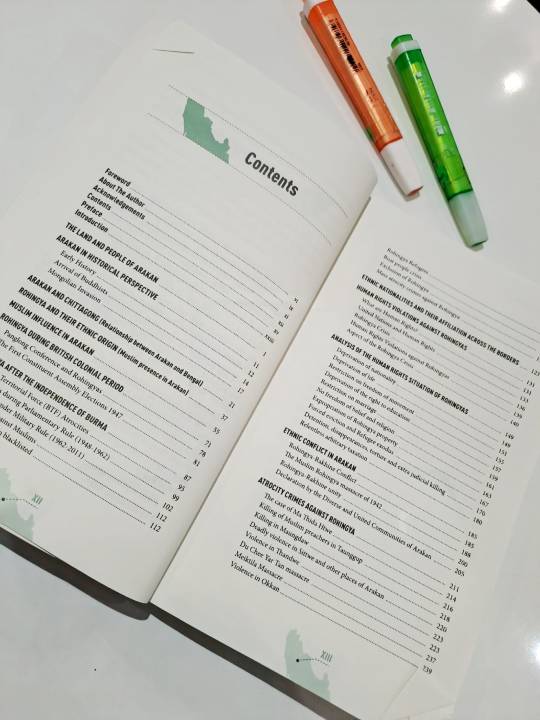
■ In my opinion, Nurul Islam is one talented author. He arranged and curated the content with the storyteller’s style of narrative, yet still academia. I learnt so many new words and terminologies. He is a thorough researcher and avid supporter of the prosecuted people. He really knows what he wrote. No parts of the book were ever just fillers. A beautiful balance of history book and “research journal”. Despite being factual and statistical, everything was filled with emotion, it can be empathising and heart-wrenching at times.
■ It was very pleasing that after the overview introduction of the whole arguments that we are going to read in this book, he started the chapters with a genuine presentation of his beloved Arakan land herself. Her mesmerising landscape, her soothing climates and her “kekayaan hasil bumi” , subhanallah! Then only the author introduces the people and cultural influences that were formed throughout the centuries, which brought us to today’s conflicts and politics.

■ The propaganda that the Burmese Buddhists Nationalists amplified to justify their heinous acts is that The Rohingya are illegal immigrants/settlers from Bangladesh.
The Arakan chronicles can be traced back to the year 2666 B.C. And its people since the establishment of many kingdoms and civilisations(From Hindu to Buddha then Islamic) from the year 100 A.D. onwards. Muslim settlements along parts of Arakan coastlines can be traced back as early as the 8th century, and the "adoption” of the Rohingya name was consolidated by the 17th century. There is evidence that the Rohingyas(Muslims) and Rakhines(Buddhists) co-existed there. They are the ethnic groups of Burma. However, their existence was not recognised, and their leaders were not even invited during the Panglong Conference. The current Burmese regime denies their heritage.


■ The Buddhist-Muslim Problems truly started in Burma from the era of the British Colonial period onwards. There were violent anti-Indian (including anti-Muslim) riots in 1930-31 and again in 1938 in which several hundreds of Indians and Muslims were killed. Muslim properties: shops, houses and mosques were looted, destroyed and burned.
Reading through the British and Japanese eras in this book reminds me of our Malaysian very own history. The tactics and treatments are very similar! Like the “Divide and Rules” concept, used to tame and manipulate the locals. Also, to instigate “nationalism”, the slogan introduced is similar: “Burma for Burmese Only Campaign”. Ours was “Tanah Melayu untuk Orang Melayu”. British Administration’s and their promises. From what I read, originally, generally, the Rohingyas were well-educated and lived in the high society, and they have mixed blood in their ancestry in addition to their Indian-like appearances. Maybe, that is why the locals envied them and discriminated against them extremely?
■ Topics that really caught my attention: 1. Panglong Conference and Rohingyas. 2. The nu-Attlee Agreement 3. Incompatible Actions with The Teachings of Lord Buddha. 4. Chapter 10: Analysis of the human rights situation of Rohingyas. 5. Chapter 11, Ethnic Conflict in Arakan. 6. The Case of Ma Thida Htwej 7. Killing of Muslim Preachers in Taunggup.
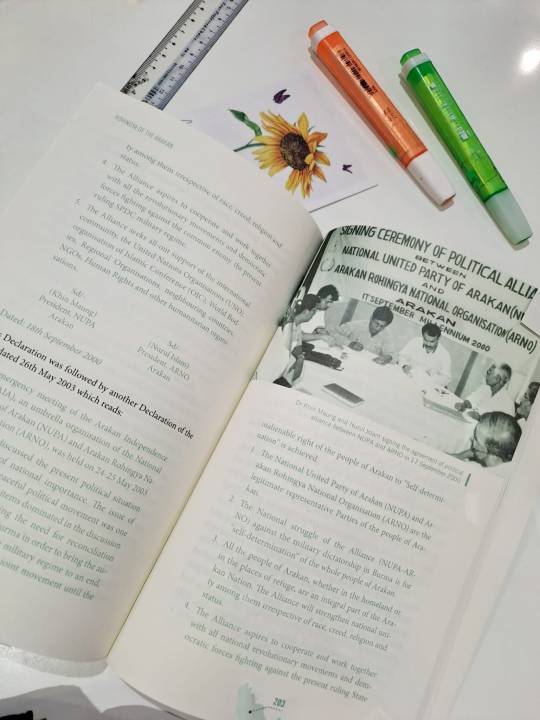
■ Apart from very few spelling errors and a lack of significant perspectives from the Buddhists on why they hate the Muslims so much, other than the slanders and rumours, this book is a well-documented overview of the issue. I hope, more authors will be inspired to write such a book to create awareness in the world society, inshaAllah.
For the rights of our brothers and sisters in Somalia, Sudan, Syria, Yemen and many more. Hasbinallah wa ni’mal wakeel.

--- ● Get the book from @dakwaislamicbks here
---
Also, follow me on:
Facebook
Instagram
Telegram
#book review#history#The Rohingya#Burmese#Muslims#Human Rights#Nurul Islam#Bibliophile#Must read#icha micha
1 note
·
View note
Note
Although MPCs website clear about bring a business which contributes a portion of profits post admin costs, Sam regularly in videos and in print interviews misrepresents. He's says my charity abd he says 59% of signup fee goes to charity. If there is a problem l, it's on Sam, who according to original members, basically sold MPC control, in 2017. Your statement of knowing what he's doing with his MPC, is questionable, post corporate change of MPC. It's not just his alone. MPC has sketchy history, since Alex's involvement, and the rumors, look more as truths that a good portion of the administrative costs go to Alex pre-whisky, for a working, guaranteed salary before sales came in. It also begs the question, if Sam is interested in supporting charity with a portion of income sales, why hasn't 10% of whisky sales went to charity partners? The whisky is part of the GGC, Sam and Alex's business. Why wouldn't he plug a Newman Products design? Maybe he's not as interested in charity?
Dear MPC Anon,
It has always been 50%, which is logical. 59% sounds like a demented Asian astrologist suggestion - but you might be unfamiliar with Burmese recent history, so I shall give you a pass, on that one.
Who are the 'original members' who told you MPC was sold? To whom was it sold? When did that happen? I need paperwork to support this statement: the current corporate documents still list ONE officer - pay away from your wallet to find out it's very probably SRH: I am not doing it for you.

Like it or not, Norouzi's involvement in MPC is a reality since at least its creation. You will have to prove me the 'sketchy' part with much more than a stinking grenade thrown by Anon or fandom illiterate gossip.
I will have to see contracts between MPC, AN, SH proving that pre-whisky launching costs of The Sassenach were drawn from the MPC accounts. I will also have to see bank and accounting documents proving so. According to US law, I would also have to be a Court and have enough reasons to subpoena these people and entities to show me those. Stop spreading the shite written by Pufflander once upon a time and ask Puffy, in her retreat, what the fuck did she do with the crowdfunded money for the Harassment PI Report (you know, *urv and co). Now that would be a really interesting question, right? No answer? Bad day, baby. Bad day.
Whisky sales under the umbrella of Great Glen Company LLC, a different legal entity with no charitable mission, were never designed to represent a charitable endeavor. I think you know the difference between a charity and a company, right? Suggesting he should give 10% of all his earnings to charity is akin to a church tithe. This argument is, of course, ridiculous, in the business world, unless there is an explicit and public vow to do so, with a particular company's benefits.
Newman's Own and the Newman's Own Foundation represent Paul Newman's personal commitment to give away 100% of Newman's Own LLC profits to charity: the Foundation serves to direct the funds to the projects its trustees deem the most appropriate, according to the Foundation's values.

This is a different story and I also hope you know the difference between Great Glen Company, a business who wants to remain a business and a ground-breaking CSR commitment like Paul Newman's. Great Glen Company and MPC are separate projects - AN's loud involvement in both does not help, though, especially with an uneducated bigot, such as yourself, Anon.
Assuming he must give 100% of all his profits to charity is absolutely ridiculous, Anon. Why don't you give away all the profits of your lemonade stand to charity and set a blazing, luminous example in this fandom?
Unless you quickly substantiate what you wrote in anger on your phone, with links, facts and names, I am forced to tell you to kindly, slowly, but surely...
FUCK OFF MY PAGE!
[Later edit:] Should I start a US Tax Law 101 course for you, Anon? To me, this rather crude company/charity montage sounds legit. Also, MPC is not a charity, as shown in my previous post.

103 notes
·
View notes
Text
Animal of the Day!
Burmese Peacock Softshell (Nilssonia formosa)

(Photo by Joel Sartore)
Conservation Status- Critically Endangered
Habitat- Southeastern Asia; India; Southern China
Size (Weight/Length)- 60 cm
Diet- Insects; Fish eggs; Fish; Small amphibians; Aquatic plants
Cool Facts- Not only does the Burmese peacock softshell turtle look like a wet pile of mud but its face is one for the history books. Instead of pulling its head back into its shell like other species of turtle, these softshells can retract its head into the skin rolls of its neck in a frankly terrifying display. Their long nose allows the majority of the Burmese peacock softshell to stay underwater while taking a breath with only their snoot poking out. Very little is known about these turtles due to their rarity. They are mostly threatened by overhunting for their meat and water pollution from gold mining along river banks.
Rating- 14/10 (Soft shell = speedy boy.)
#animal of the day#animals#turtles#reptiles#tuesday#june 13#burmese peacock softshell#softshell turtle#biology#science#conservation#the more you know
442 notes
·
View notes
Text

A savvy businesswoman, Osoet Pegua (c.1615–c.1658) was connected to both the royal court of Siam (now Thailand) and the Dutch East India Company (VOC). Her business acumen helped her secure a role as an invaluable partner in the region.
Here is the link to my Ko-Fi. If you enjoy my content, your support would be much appreciated!
Early Life
Osoet was born around 1615 and was of Mon-Burmese descent, placing her at the margins of Thai society. By unknown circumstances, she ended up in the Dutch compound in Ayutthaya, then the capital of Siam and a major trading post. She lived in a world where female traders often held substantial influence and had strong networks.
Many foreign men who arrived were single and frequently took local wives or concubines. Osoet herself would be involved with three Dutchmen.
At age 16, she became the concubine of Jan van Meerwijck and later had a son with him. After his death in 1635, she sought a new relationship.
A Respected Trading Partner
Osoet’s next partner was Jeremias van Vliet, who became director of the VOC’s office in Ayutthaya. Osoet, already a skilled and well-connected businesswoman, proved invaluable to the Dutch by facilitating connections with the royal court, including the king himself. This helped advance Dutch commercial interests. She also worked with the wives of high-ranking officials, underscoring the political and commercial roles of aristocratic women.
Osoet had three daughters with van Vliet. He wanted to take custody of them and move them out of the country, but Osoet refused. The king supported her decision, a testament to her respected position. Osoet was thus able to keep her daughters.
Behind-the-Scenes Leadership
Osoet later met Jan van Muijden, who also became the VOC director. She entered into a relationship with him when she was around 31 and he was 25. Lacking experience in managing an office and barely speaking the local language, van Muijden relied heavily on Osoet. She unofficially took charge of VOC operations, using her contacts to secure trading licenses for him.
Her influence peaked between 1646 and 1650, during which the company prospered thanks to her court connections. She negotiated lucrative contracts and even gained a monopoly on supplying provisions for the Dutch establishment in Ayutthaya.
Osoet died in 1658 following a stroke that left her paralyzed and unable to speak. At the Dutch’s request, she was given a Christian burial in the Company’s graveyard, rather than being cremated
Further reading:
Delouche Gilles, Une femme d’affaires et d’influence à Ayudhya au XVIIe siècle : Dame O-Sut (? -1658)
Djik Wil O., “Sex and trade in seventeenth century Siam. Osoet Pegu and her Dutch lovers”
Smith Bonnie G., Women's History in Global Perspective volume 2
#osoet pegua#history#women in history#women's history#historyedit#17th century#thailand#thai history#south east asia#south east asian history#asian history#historyblr
49 notes
·
View notes
Text

1942 05 Burma Chennault's Flying Tigers - Robert Taylor
Strangled by the Japanese blockade of its sea ports, and with its supplies from Russia diverted to combat Hitler’s invasion in the South, China was left with but one lifeline for vital supplies from the outside world: A treacherous unpaved track hacked through mountain terrain linking the vital port of Rangoon with the city of Kunming, in South West China – it was the infamous Burma Road.With the Imperial Japanese air force hell-bent on destroying China’s last supply link, opposition had almost evaporated but for a tiny “air force” of American volunteers led by the indomitable figure of Claire Chennault.Formed in early 1941, many months before Pearl Harbor, a rag-tag bunch of 100 recruited flyers supported by 200 ground personnel, known officially as the American Volunteer Group came together to stand alone against the might of the Japanese air force in Indo-China. During their brief existence this remarkable group became one of the most successful and famous fighter units of all time. Blazing a trail in the skies over Burma and China they created a legend that will remain in the folklore of aviation history. They were Chennault’s FLYING TIGERS. With little official support from home and almost without replacement aircraft or spares, the P-40 Tomahawk pilots of the AVG became the scourge of the Japanese air force and the heroes of the Chinese people. In a six month period of combat, with no more than 50 or 60 serviceable aircraft at anyone time, and almost always heavily outnumbered in the air, they destroyed some 300 Japanese aircraft, while probably damaging or destroying another 300, and caused incalculable damage to Japanese ground resources. Their brief, glorious existence came to an end when, on July 4, 1942, the AVG was absorbed into the U. S. Army Air Corps and Chennault’s Flying Tigers passed into history.Moved by the exhilarating legend of the Flying Tigers, Robert Taylor has created one of his finest masterpieces. Capturing perfectly the spirit of the Flying Tigers “CHENNAULT’S FLYING TIGERS” portrays a scene typical of the distant war fought by this tiny band of warriors. Depicted in the foreground of Robert’s dramatic and spectacular combat scene are two P-40 Tomahawks of the 2nd pursuit squadron, the “Panda Bears,” as they pull out of their diving attack just above the tree-tops of the Burmese jungle. One bomber hits the water, as two more P-40s bear down on another Nakajima bomber. In the distance the air is busy with low-level combat.
20 notes
·
View notes
Text
PHYOE PHYOE AUNG // ACTIVIST
“She was a student activist and former political prisoner from Burma (Myanmar). She was involved in the Saffron Revolution of 2007. She was arrested in 2008 and sentenced to four years in prison. After her release she became the general secretary of the All Burma Federation of Student Unions. Arrested again in 2015 for taking part in protests over a new National Education Law which activists claim restricts academic freedom. About 126 students were imprisoned, some of whom claim to have been tortured. Phyoe Phyoe Aung was released in April 2016.”


2 notes
·
View notes
Text
"This is an excerpt from my memoir, "Love and Truth”.
Roger Waters
This is a true story of My love for two animals Both wild in their own way Which I read to the audience at a Live performance of DSOTM REDUX At the London Palladium On the day after October 7th 2023. Yes, The Campaign Against Anti-Semitism Were outside the Theater that day trying to cancel me. Free Palestine! From the River to the Sea! ✊🏻🇵🇸🇵🇸🇵🇸
So Chocolate Charlie Brown was my third brown Burmese cat. This is a drawing of him and his friend Lilly, an Abyssinian, above the skirting board on the wall of my youngest son Jack’s room in the early nineties. This story isn’t about Chocolate Charlie Brown, well, just this first little bit is, but the rest is about a Duck called Donald. First though a brief history of Chocolate Charley Brown, I got him through Keith Butt, the vet in Knightsbridge where I used to take pets to be euthanized on Sunday mornings if they were beyond repair. Like Cloudy for instance, my daughter India’s pet gerbil, she was beyond repair, cancer, (Cloudy that is, not India), poor little scrap. So into the Merc we jumped one Sunday morning after breakfast, Cloudy and I, well Cloudy didn’t exactly jump in, if truth be told, I had to help her in, in her little cage, just the two of us, the condemned Cloudy and me, and a cardboard box for later. Bloody hell, I’m getting a bit weepy. Off to Keith Butt, Mr Butt was already cognizant of Cloudy’s condition, so, look the other way, is it over? The trick before bringing the deceased home was to make her look comfy in her little cardboard box, arranged curled up resting in eternal peace with a garland of forget me nots. After lunch, down the garden, spade in hand, a not very heavy cardboard box, a little girl’s hand, held tightly in mine. Job done.
What was I talking about? Oh yeah, Chocolate Charley Brown. The day he arrived he was a wee brown scrap and scared shitless, so I took him upstairs to the bedroom for a settle in. He ran straight under the bed and wouldn’t come out, so I took off my cowboy boots and got into bed in my jeans and dangled enticing things like feathers on bits of string in front of the dark places under the bed. Sure enough after about half an hour the hunting gene emerged and so did CCB’s little paw. I enticed him out into the open and then scooped him up and stuffed him under the covers next to my big warm leg. I was wearing a brown leather belt to hold my jeans up. I’ve still got it, it’s got a silver tip that always flops down. I was sitting up in the bed reading when I saw a tiny paw reach out and bat at the dangling silver bit on the end of my belt. We said hello, and we were inseparable after that. What a magnificent animal CCB was, beloved by all. Well obviously not all, all. He was not beloved by rodents or birds or Brian the gamekeeper from Kimbridge Farms next door. I saw CCB limping one day, favouring his off hind. I couldn’t find anything amiss, nothing broken, but, just to be sure I took him to the local vet for an X-Ray. Bugger me! Three #5 shot gun pellets in his rear end. I went to see Brian.
“Er Brian?”
“Yes, Sir?”
“Happy Christmas Brian, there’s a hundred quid.”
“Thank you very much Sir!”
“You’re very welcome…….. Brian, If that big old brown cat of mine is still alive next Christmas there’ll be another hundred, and so on until he dies of natural causes.”
“I hear you Mr Waters, can I ask you a favour?”
“Anything Brian”
“Could you put a fluorescent collar on ‘im sir? Make my job a lot easier, that would.”
Anyway, one summer I hear the cat flap bang, and in comes CCB with, as usual, something dead in his mouth. He flops down in front of the AGA Stove, (half central heating, half cooking, much beloved in posh country kitchens) panting.
“What you got there Charlie?”
“Oh nothing much, just a newly hatched duckling, I’ve already eaten all it’s siblings and I’m a bit full. I’m just gonna rest here for a minute and then eat this‘un later and then I might go for a kip in the laundry room.”
“Jesus Christ Charlie, let’s have a look, oh for fuck’s sake it’s still wet.”
“Cats will be cats son”
“Jesus! Come on little‘un it’s the bin for you. Fuck me it’s still breathing, Jesus! Charley!”
“Oi! where are you going, I was looking forward that.”
So I put the wet scrap of baby bird, bits of shell and all, out of reach of the magnificent beast and went in search of a shoe box. Got one. Screwdriver for holes. Dap, dap, dap, dap, dap, dap, dap, dap, dap, dap. That’s enough, it’ll never live anyway. Where to put it? I know, guest bathroom on the radiator.
Next morning drinking coffee. Halfway through second cup….! The shoebox! I better go and clear up the remains. So, I run up the stairs and go into the guest bathroom.
“Tsi Tsi Tsi Tsi Tsi”
Fuck me! Open the lid. Oh my god it’s a fluffy brown golf ball with a little yellow face and a line of mascara through its eye!
“Tsi Tsi Tsi Tsi Tsi “
“Tsi Tsi Tsi Tsi Tsi”
“Tsi Tsi Tsi Tsi?”
“Tsi Tsi Tsi Tsi?”
“Tsi Tsi Tsi”
“Tsi Tsi Tsi Tsi Tsi”
Translation; Mallard to English.
“Mummy, Mummy, Mummy, Mummy, Mummy,
I’m hungry, I’m hungry, I’m hungry, I’m hungry, I’m hungry,
Where have you been?
Where have you been?
I was frightened,
Mummy, Mummy, Mummy, Mummy, Mummy.”
It was Donald.
“Fuck me! ……….. What do they eat?”
“What about milk ?”
“Milk! Don’t be stupid, when did you ever see a duck with tits?”
Ducklings should be fed a diet of mealworms and plant matter at an early age, though grasses tend to make baby ducks bloat. Wild ducks tend to stick to whatever bugs they find, and they will eat food that is fed to them by park visitors or guests. Bread has been long regarded as a bad thing to feed wild birds.
“Oi, no bread!”
I probably went out to try and catch bugs on the river that runs through the garden. Duh! Have you ever tried to catch a bug? Exactly! It probably didn’t take me long to read up on it.(Roger all through your life you’ll be faced with many challenges, my advice is to read, read, read, read. Thanks Mum.) Dried mealy worms mixed with crushed barley or oats, and water of course. Donald stayed in the guest bathroom for the first week or so, except of course at my bath time when he came into the master bathroom for bath time with me.
What bliss, my own duck to play with in the bath. Donald loved bath time, swimming about and then coming up onto Mummy’s chest for a snuggle and a bit of chin peck preen time, then back into the warm water.
What has always intrigued me is how can something that small produce that volume of duck shit? I mean, the guest bathroom floor was knee deep after a couple of weeks. I know you think I’m exaggerating; you’re thinking.
“How could it possibly be knee deep?”
“Ah, well that’s because you’re thinking Mummy knee deep, I’m talking Donald knee deep, which as you can see from the photo is only about half an inch.”
Anyway Donald grew and grew, I taught him to swim in the bath, even thought of buying him a plastic duck to play with……..no I didn’t!
The guest bathroom started to pong a bit, and it was a warm summer, so I decided to build Donald a run in the garden. We had a very small stream, only about a foot wide, that ran from a parallel carrier stream across the lawn under some cherry trees to the main river. Perfect.
I got some chicken wire and built an enclosure which spanned the stream. Running water, fox proof, enough bank for a snooze, in sight of the chairs on the logia, heaven. The long summer days of, what? 1993? Passed. Donald grew and grew, never losing his attachment to me, his Mummy. We used to go for walks together down the garden, never too close to the main river, I was always afraid of him falling in. Stupid I know. I was living at the time with Pricilla, my Jack’s mum, and we were in the habit of sitting on the logia at the cocktail hour with a very large vodka and cranberry juice each. I know, I know, but in those days we didn’t know any better. Anyway, Donald would always come and sit with us and preen a bit and quack-le quietly until bedtime. I’m not sure how many months passed before one day I looked at Donald and I thought, fuck me shouldn’t his head be starting to turn green? Christ almighty! Donald’s a girl! Well, too late to change his/her name now. Thank god, (NTTIAG) as far as we know, ducks don’t have pronoun issues.
One day, as September approached, I was looking at Donald over the rim of my vodka glass thinking, that duck looks almost full grown, when another thought occurred to me………………………..?
“Christ she can’t fly.”
So I called her over and picked her up and held her between my thumb and the four fingers of my right hand, half way between her lovely neck and her beautiful webbed feet, like a fat feathered paper dart, and pointing her slightly up, launched her forward. She didn’t even flap her wings, just nosedived into the turf at my feet, looked over her shoulder at me disapprovingly and waddled off to lick her wounded pride.
“Jesus Mummy! Why’d you do that?”
It was a conundrum, how to teach Donald to fly, until one day walking down the edge of one of the paddocks on my way to give Mossy Fern (Retired racehorse) some polos, I was going too fast for Donald who broke into a stumbling waddle-y run and then instinctively put out her wings and flapped and flew for about five yards before crashing. Eureka! We started to practice every day and before long if I broke into a run she would fly beside me at shoulder height,
“Look at me Mummy I’m flying!”
She didn’t fly away. Until one day she did.
“Where’s Donald?”
“I don’t know I haven’t seen her.”
I’m a bit weepy writing this………I mean it was great that she’d gone off with her friends to the barley stubble or wherever they went, but……………well it left a big hole.
Then a couple of days later, a few ducks landed by the bridge, below the top pool, near the house, when we were sitting in front of the logia with our Vodkas and cranberry juice, and one of them swam over, calmly climbed the steps out of the river, walked across the lawn and sat down next to us.
“Hello Donald.”
“Quack, quack,”
She did that several more times that September, until finally she didn’t.
I confess, though it pains me to admit it, before 1993, I would occasionally take the odd barley fed mallard off the river in September, delicious.
That was thirty years ago.
I never did it again."
via substack © by Roger Waters
#found today#it is one of the most delightful things I have read this year!!!#shit roger#then he has a heart too!!!#and also i like the way he writes#roger waters#roger and his baby duck#and other animals#pink floyd#memoir
17 notes
·
View notes
Text

Sao and Inge take the car out in Hsipaw.
0 notes
Note
hi! SUPER interesting excerpt on ants and empire; adding it to my reading list. have you ever read "mosquito empires," by john mcneill?
Yea, I've read it. (Mosquito Empires: Ecology and War in the Greater Caribbean, 1620-1914, basically about influence of environment and specifically insect-borne disease on colonial/imperial projects. Kinda brings to mind Centering Animals in Latin American History [Few and Tortorici, 2013] and the exploration of the centrality of ecology/plants to colonialism in Plants and Empire: Colonial Bioprospecting in the Atlantic World [Schiebinger, 2007].)
If you're interested: So, in the article we're discussing, Rohan Deb Roy shows how Victorian/Edwardian British scientists, naturalists, academics, administrators, etc., used language/rhetoric to reinforce colonialism while characterizing insects, especially termites in India and elsewhere in the tropics, as "Goths"; "arch scourge of humanity"; "blight of learning"; "destroying hordes"; and "the foe of civilization". [Rohan Deb Roy. “White ants, empire, and entomo-politics in South Asia.” The Historical Journal. October 2019.] He explores how academic and pop-sci literature in the US and Britain participated in racist dehumanization of non-European people by characterizing them as "uncivilized", as insects/animals. (This sort of stuff is summarized by Neel Ahuja, describing interplay of race, gender, class, imperialism, disease/health, anthropomorphism. See Ahuja's “Postcolonial Critique in a Multispecies World.”)
In a different 2018 article on "decolonizing science," Deb Roy also moves closer to the issue of mosquitoes, disease, hygiene, etc. explored in Mosquito Empires. Deb Roy writes: 'Sir Ronald Ross had just returned from an expedition to Sierra Leone. The British doctor had been leading efforts to tackle the malaria that so often killed English colonists in the country, and in December 1899 he gave a lecture to the Liverpool Chamber of Commerce [...]. [H]e argued that "in the coming century, the success of imperialism will depend largely upon success with the microscope."''
Deb Roy also writes elsewhere about "nonhuman empire" and how Empire/colonialism brutalizes, conscripts, employs, narrates other-than-human creatures. See his book Malarial Subjects: Empire, Medicine and Nonhumans in British India, 1820-1909 (published 2017).
---
Like Rohan Deb Roy, Jonathan Saha is another scholar with a similar focus (relationship of other-than-human creatures with British Empire's projects in Asia). Among his articles: "Accumulations and Cascades: Burmese Elephants and the Ecological Impact of British Imperialism." Transactions of the Royal Historical Society. 2022. /// “Colonizing elephants: animal agency, undead capital and imperial science in British Burma.” BJHS Themes. British Society for the History of Science. 2017. /// "Among the Beasts of Burma: Animals and the Politics of Colonial Sensibilities, c. 1840-1940." Journal of Social History. 2015. /// And his book Colonizing Animals: Interspecies Empire in Myanmar (published 2021).
---
Related spirit/focus. If you liked the termite/India excerpt, you might enjoy checking out this similar exploration of political/imperial imagery of bugs a bit later in the twentieth century: Fahim Amir. “Cloudy Swords” e-flux Journal Issue #115. February 2021.
Amir explores not only insect imagery, specifically caricatures of termites in discourse about civilization (like the Deb Roy article about termites in India), but Amir also explores the mosquito/disease aspect invoked by your message (Mosquito Empires) by discussing racially segregated city planning and anti-mosquito architecture in British West Africa and Belgian Congo, as well as anti-mosquito campaigns of fascist Italy and the ascendant US empire. German cities began experiencing a non-native termite infestation problem shortly after German forces participated in violent suppression of resistance in colonial Africa. Meanwhile, during anti-mosquito campaigns in the Panama Canal zone, US authorities imposed forced medical testing of women suspected of carrying disease. Article features interesting statements like: 'The history of the struggle against the [...] mosquito reads like the history of capitalism in the twentieth century: after imperial, colonial, and nationalistic periods of combatting mosquitoes, we are now in the NGO phase, characterized by shrinking [...] health care budgets, privatization [...].' I've shared/posted excerpts before, which I introduce with my added summary of some of the insect-related imagery: “Thousands of tiny Bakunins”. Insects "colonize the colonizers". The German Empire fights bugs. Fascist ants, communist termites, and the “collectivism of shit-eating”. Insects speak, scream, and “go on rampage”.
---
In that Deb Roy article, there is a section where we see that some Victorian writers pontificated on how "ants have colonies and they're quite hard workers, just like us!" or "bugs have their own imperium/domain, like us!" So that bugs can be both reviled and also admired. On a similar note, in the popular imagination, about anthropomorphism of Victorian bugs, and the "celebrated" "industriousness" and "cleverness" of spiders, there is: Claire Charlotte McKechnie. “Spiders, Horror, and Animal Others in Late Victorian Empire Fiction.” Journal of Victorian Culture. December 2012. She also addresses how Victorian literature uses natural science and science fiction to process anxiety about imperialism. This British/Victorian excitement at encountering "exotic" creatures of Empire, and popular discourse which engaged in anthropormorphism, is explored by Eileen Crist's Images of Animals: Anthropomorphism and Animal Mind and O'Connor's The Earth on Show: Fossils and the Poetics of Popular Science, 1802-1856.
Related anthologies include a look at other-than-humans in literature and popular discourse: Gothic Animals: Uncanny Otherness and the Animal With-Out (Heholt and Edmunson, 2020). There are a few studies/scholars which look specifically at "monstrous plants" in the Victorian imagination. Anxiety about gender and imperialism produced caricatures of woman as exotic anthropomorphic plants, as in: “Murderous plants: Victorian Gothic, Darwin and modern insights into vegetable carnivory" (Chase et al., Botanical Journal of the Linnean Society, 2009). Special mention for the work of Anna Boswell, which explores the British anxiety about imperialism reflected in their relationships with and perceptions of "strange" creatures and "alien" ecosystems, especially in Aotearoa. (Check out her “Anamorphic Ecology, or the Return of the Possum.” Transformations. 2018.)
And then bridging the Victorian anthropomorphism of bugs with twentieth-century hygiene campaigns, exploring "domestic sanitation" there is: David Hollingshead. “Women, insects, modernity: American domestic ecologies in the late nineteenth century.” Feminist Modernist Studies. August 2020. (About the cultural/social pressure to protect "the home" from bugs, disease, and "invasion".)
---
In fields like geography, history of science, etc., much has been said/written about how botany was the key imperial science/field, and there is the classic quintessential tale of the British pursuit of cinchona from Latin America, to treat mosquito-borne disease among its colonial administrators in Africa, India, and Southeast Asia. In other words: Colonialism, insects, plants in the West Indies shaped and influenced Empire and ecosystems in the East Indies, and vice versa. One overview of this issue from Early Modern era through the Edwardian era, focused on Britain and cinchona: Zaheer Baber. "The Plants of Empire: Botanic Gardens, Colonial Power and Botanical Knowledge." May 2016. Elizabeth DeLoughrey and other scholars of the Caribbean, "the postcolonial," revolutionary Black Atlantic, etc. have written about how plantation slavery in the Caribbean provided a sort of bounded laboratory space. (See Britt Rusert's "Plantation Ecologies: The Experiential Plantation [...].") The argument is that plantations were already of course a sort of botanical laboratory for naturalizing and cultivating valuable commodity plants, but they were also laboratories to observe disease spread and to practice containment/surveillance of slaves and laborers. See also Chakrabarti's Bacteriology in British India: laboratory medicine and the tropics (2012). Sharae Deckard looks at natural history in imperial/colonial imagination and discourse (especially involving the Caribbean, plantations, the sea, and the tropics) looking at "the ecogothic/eco-Gothic", Edenic "nature", monstrous creatures, exoticism, etc. Kinda like Grove's discussion of "tropical Edens" in the colonial imagination of Green Imperialism.
Dante Furioso's article "Sanitary Imperialism" (from e-flux's Sick Architecture series) provides a summary of US entomology and anti-mosquito campaigns in the Caribbean, and how "US imperial concepts about the tropics" and racist pathologization helped influence anti-mosquito campaigns that imposed racial segregation in the midst of hard labor, gendered violence, and surveillance in the Panama Canal zone. A similar look at manipulation of mosquito-borne disease in building empire: Gregg Mitman. “Forgotten Paths of Empire: Ecology, Disease, and Commerce in the Making of Liberia’s Plantation Economy.” Environmental History. 2017. (Basically, some prominent medical schools/departments evolved directly out of US military occupation and industrial plantations of fruit/rubber/sugar corporations; faculty were employed sometimes simultaneously by fruit companies, the military, and academic institutions.) This issue is also addressed by Pratik Chakrabarti in Medicine and Empire, 1600-1960 (2014).
---
Meanwhile, there are some other studies that use non-human creatures (like a mosquito) to frame imperialism. Some other stuff that comes to mind about multispecies relationships to empire:
Lawrence H. Kessler. “Entomology and Empire: Settler Colonial Science and the Campaign for Hawaiian Annexation.” Arcadia (Spring 2017)
No Wood, No Kingdom: Political Ecology in the English Atlantic (Keith Pluymers)
Archie Davies. "The racial division of nature: Making land in Recife". Transactions of the Institute of British Geographers Volume 46, Issue 2, pp. 270-283. November 2020.
Yellow Fever, Race, and Ecology in Nineteenth-Century New Orleans (Urmi Engineer Willoughby, 2017)
Pasteur’s Empire: Bacteriology and Politics in France, Its Colonies, and the World (Aro Velmet, 2022)
Tom Brooking and Eric Pawson. “Silences of Grass: Retrieving the Role of Pasture Plants in the Development of New Zealand and the British Empire.” The Journal of Imperial and Commonwealth History. August 2007.
Under Osman's Tree: The Ottoman Empire, Egypt, and Environmental History (Alan Mikhail)
The Herds Shot Round the World: Native Breeds and the British Empire, 1800-1900 (Rebecca J.H. Woods, 2017)
Imperial Bodies in London: Empire, Mobility, and the Making of British Medicine, 1880-1914 (Kristen Hussey, 2021)
Red Coats and Wild Birds: How Military Ornithologists and Migrant Birds Shaped Empire (Kirsten Greer, 2020)
Animality and Colonial Subjecthood in Africa: The Human and Nonhuman Creatures of Nigeria (Saheed Aderinto, 2022)
Imperial Creatures: Humans and Other Animals in Colonial Singapore, 1819-1942 (Timothy P. Barnard, 2019)
Biotic Borders: Transpacific Plant and Insect Migration and the Rise of Anti-Asian Racism in America, 1890-1950 (Jeannie N. Shinozuka)
#ecology#bugs#multispecies#landscape#indigenous#haunted#temporal#colonial#imperial#british entomology in india#mosquitoes#carceral#tidalectics#intimacies of four continents#carceral geography#pathologization#indigenous pedagogies#black methodologies#kathryn yusoff#katherine mckittrick#my writing i guess
90 notes
·
View notes
Text
Japanuary: Introduction

Well, holy shit, what year is it? It's been 4 years since I tried this whole Tumblr thing, and...eh, it wasn't the most successful endeavor ever, but fuck it! It was a fun ride in 2021! I tried to do the whole one-film-per-day thing, stuck with it for a while, and eventually failed that challenge. And I'm not gonna pretend that watching a movie a day and writing a blog post about it is possible with my current schedule, BUT! Even then, I have enjoyed the whole endeavor. So, why not give this shindig another spin? And how do I plan to do that? Easy: with a monthly themed challenge once again.
This time, though, let's not do Action in January. In fact, why be bound to genre at all this time? Theme, sure, but let's stretch the genre limit a bit here. So, with that, let's start a brand new month and a brand new year with a brand new theme...and a very-little touched country on this blog: 日本国.

Japan, sometimes known as the Sun's Origin (a direct translation of the country's name; "the Land of the Rising Sun" is a Western epithet), is one of the biggest movie-producing countries on the planet, since almost the beginning of cinema. However, the Golden Age of Japanese cinema began in the 1940s and 1950s, when prominent directors rose in the fallout of World War II. Pun...technically not intended, but valid all the same. Storytelling and tradition are treasured practices in Japanese culture, which is strong to this day. However, years of self-imposed isolation, followed by rapid acceptance of Western influence, definitely made film an interesting development in those storytelling traditions. While originally Western-influenced, Japan definitely injected itself into 35mm camera tape starting in the 1910s. And that continued, often through propaganda film, until...uh...well...

If you know, you unfortunately know, if terms of the above GIF. But, yeah, World War II happened, and Japan was involved and affected in...various ways. In any case, its civilian population was heavily traumatized, and that showed itself through the film industry especially. While wartime film really was a lot of propaganda about the Empire of Japan, it also came with a lot of restrictions, especially when Western influence was suspected. So, after the war ended with Japan surrendering, and the heavy boot of America made itself known in Japanese everyday life, the film industry was affected positively and negatively. On one hand, much of Japan's film history was literally burned for fear of its potentially offensive nature. Plus, jidaigeki, or samurai films, became incredibly difficult to make. Not impossible, but that's a point for later.
It's during this time that a number of prominent Japanese directors start popping up, or coming back into significance. Of note are Akira Kurosawa (MUCH more on him soon) and Yasujirō Ozu, amongst several others. Film stars like Toshiro Mifune also begin to appear. Japanese films also began their international spread, and suddenly, they also began to become popular in the United States and the Western world. By the time the 1950s came, Japan's film industry had entered its new, golden age, and that decade saw some of the most famous films in the country's history.

I've previously talked about Akira Kurosawa's Rashomon, which came out in 1950, but that's just the tip of the iceberg. Seven Samurai, Tokyo Story, Ikuru, The Burmese Harp, The Human Condition, Ugetsu Monogatari (which I've also talked about), Sansho the Bailiff, Floating Weeds, amongst several others. All in the 1950s. Badass. I feel like there's a major one I'm missing, too, but I can't list every Japanese film ever made. You get the idea: Japanese film is sort of a big deal.
Despite this, though, when television spread throughout the succeeding decades, the film industry died back a tiny bit. CHina began their own blockbuster film industry with the boom of wuxia, and Japanese filmmakers became more experimental in their work, appealing less to the masses as a result. The two studio giants in Japan, then and now, were Toho Co., Ltd. and Toei Company, Ltd. Even then, neither company did great during the 60s and 70s. Toei would eventually find its footing in the world of anime, while Toho found its footing in...OH RIGHT

Sorry, Godzilla, almost forgot about you. This science-fiction horror (and yes, it is a horror film in an existential sense) would put an indelible stamp on the industry for DECADES, and would also color people's perception of Japanese films in the west for a while. That, combined with the resurgance in jidaigeki, would prove a bit of a downfall in terms of Western popularity. But even then, the film industry kept chugging along, and Japan did eventually find a new way to appeal to the Western world. Now, I'm skipping over a HELL of a lot of history (basically the entire '80s and the mini-theatre craze), but there's good reason for that.
See, once we get to the '80s and '90s, new directors suddenly step into the limelight. Takeshi Miike shocks people with Audition, which also becomes part of a new horror tradition in Japanese cinema that gets a LOT of attention. Hirokazu Kore-eda moves from documentaries in the '60s, and makes several films over the years up through the '90s, like Maborosi and After Life. And then, in the late 1980s, a new animated film based on the Lupin the Third franchise brings a new director into the public consciousness...and EVERYBODY starts paying attention again.

Hayao Miyazaki and Studio Ghibli come into prominence, and film is back, baby! And I mean that; Porco Rosso, that one Miyazaki movie with humanoid pigs, was more popular than E.T. the Extra-Terrestrial, for one example. Satoshi Kon and Isao Takahata come into the fray, and large movie theatres also become more prevalent after their decline decades later. And now, Toei is making anime for Japan and the Western world, where it's EXPLODING. Suddenly, Japanese media is popular worldwide, and they never go back. The anime industry exponentially expands, and more films can be made and distributed. Hell, Toei also gets rich from the trend of sentai shows, which the Western world will most closely associate with Power Rangers! Seriously, shit starts to blow up.
Today, most people associate Japanese media with either anime or Godzilla, which is...simplistic. But, hey, there's a FUCKTON of Japanese media out there, and I've personally explored precious little of it. So when I was settling on watching more films this coming year, I was looking for ideas. And then I stumbled on one: Japanuary. Not an original idea on my part, and you can check out other lists for it (like this one, this one, and this one, for starters), but I'm into it! Of course...there is one caveat.

I, uh...I didn't watch all of these in January. I actually started in November.
NOVEMBER WAS A DIFFICULT MONTH!!! And not even for all the reasons you'd expect. But, honestly, I missed updating this blog. And I knew that, to do so in a timely fashion, I'd need a lot of extra time. So, to get that extra time, I started real early. And in truth, I'm writing this post from the past (specifically November 8. YES IT HAS ALREADY BEEN A DIFFICULT MONTH). Still, I'll be putting out the full list of films I'll talk about this month in this post! And, if this came out on December 30th as planned, that means I actually did it! Otherwise, this post would be left in the drafts, to die a slow and unfulfilled death. So, fingers crossed that you're reading this right now!
And so, with that said, here is my list for Japanuary 2025! Feel free to watch along if you can (so will I, believe me), and happy New Year!
Ikiru (1952; dir. Akira Kurosawa)
Throne of Blood (1957; dir. Akira Kurosawa)
Yojimbo (1961; dir. Akira Kurosawa)
High and Low (1963; dir. Akira Kurosawa)
Ran (1985; dir. Akira Kurosawa)
Late Spring (1949; dir. Yasuijirō Ozu)
Tokyo Story (1953; dir. Yasuijirō Ozu)
The 47 Ronin (1941; dir. Kenji Mizoguchi)
Sansho the Bailiff (1954; dir. Kenji Mizoguchi)
Harakiri (1962; dir. Masaki Kobayashi)
The Ballad of Narayama (1983; dir. Shōhei Imamura)
Fireworks (1997; dir. Takeshi Kitano)
Audition (1999; dir. Takeshi Miike)
Sukiyaki Western Django (2007; dir. Takashi Miike)
Nausicaa of the Valley of the Wind (1984; dir. Hayao Miyazaki)
Castle in the Sky (1986; dir. Hayao Miyazaki)
Porco Rosso (1992; dir. Hayao Miyazaki)
The Secret World of Arrietty (2010; dir. Hayao Miyazaki)
The Boy and the Heron (2023; dir. Hayao Miyazaki)
Perfect Blue (1997; dir. Satoshi Kon)
Tokyo Godfathers (2003; dir. Satoshi Kon)
Wolf Children (2012; dir. Mamoru Hosoda)
Mirai (2018; dir. Mamoru Hosoda)
Nobody Knows (2004; dir. Hirokazu Kore-eda)
Shoplifters (2018; dir. Hirokazy Kore-eda)
Godzilla (1954; dir. Ishirō Honda)
Godzilla Minus One (2023; dir. Takashi Yamazaki)
Tampopo (1985; dir. Jūzō Itami)
Mishima: A Life in Four Chapters (1985; dir. Paul Schrader)
Drive My Car (2021; dir. Ryūsuke Hamaguchi)
Tokyo Gore Police (2008; dir. Yoshihiro Nishimura)
#user365#365 days 365 movies#365 movie challenge#365 movies 365 days#365 movies a year#365days365movies#movie challenge#japanuary#japanese film#japanese movie#japanese cinema#monthly movie challenge#challenge month#japan#akira kurosawa#ishiro honda#mamoru hosoda#hayao miyazaki#satoshi kon#yasujiro ozu#kenji mizoguchi#takeshi miike
15 notes
·
View notes
Text
Oh, Marple...
You 'don't want to attack me', eh?
You don't say:
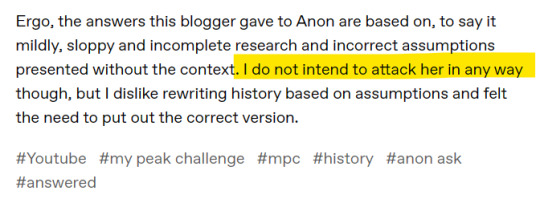
That being said, this is exactly what you abundantly do, in your last post.
Where you do lie in plain sight, just because hey, why not?
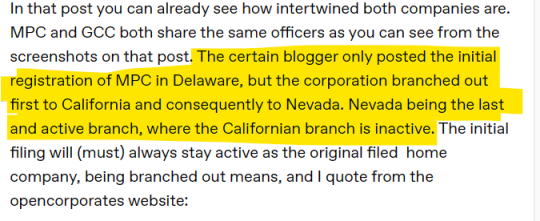
This is what I wrote in another post that triggered that particular nasty Anon. This one, to be exact: https://www.tumblr.com/sgiandubh/749135029068759040/charities-and-politics-the-thin-red-line. You can re-read it in context and make your own idea, people:

I cannot believe that a person who manages to find SRH jogging in London on a damn timelapse video is unable to find the obvious connection between that post, the Anon and my obvious correct take on the matter.
But it did not serve your manipulative and denigrating (at all costs, even the ridicule) agenda, did it?
Also, my take on Norouzi is legally correct. He has been involved in that LLC business project way before its incorporation, as you painstakingly try to prove at length. You say it yourself: MPC was incorporated as an LLC in 2017, he's been around since 2016. Some former members of this fandom might even have a couple of not very nice things to add about his appropriation of their own MPC-related ideas, but let's not dwell too much on it, shall we?
Here is what you write:

And, unlike many Anons, you do know the difference between a collaboration (informal) and a company (legally enforced business project). You even have the nerve to write:

Eh: law is seldom made with sentiments, of course. Very often with opportunities and interests. You are not sloppy, that being said. You are a damn manipulator of the first order and you know exactly what you are doing.
In fact, why don't I just repost that Anon's submission, for everyone to see? It was full with crap and insinuations - something you know very well, too:
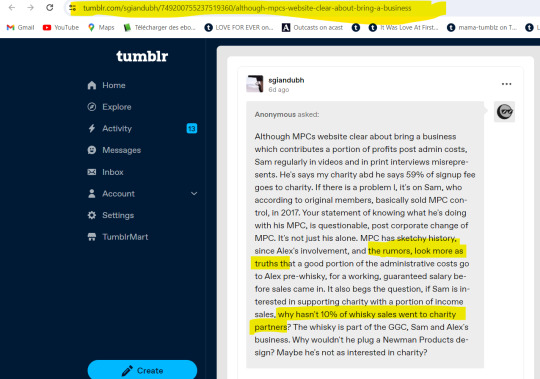
But you just wanted to make me look like a fool, didn't you?
About the demented Asian astrologer, well. There is your explanation. You must not be familiar with Burmese recent history, either:
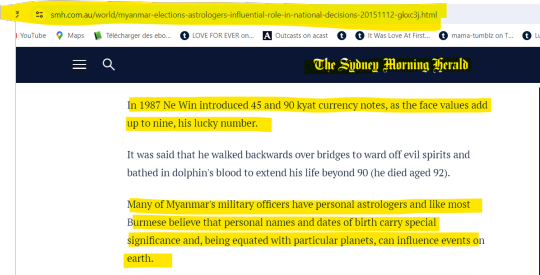
Ne Win was the Burmese military dictator from 1962 to 1988, for your information. I was just joking - but I think you sincerely believe you are the only person on Earth to have that privilege. It was very daring of me to bring my cheap humor in here and derange your over-inflated righteousness. I am not even sorry.
Coming from a retired (?) music teacher with a degree in business, your claims to legal proficiency make me laugh, Marple. I wonder what else do you need, my scanned degree on a plate?
PS: don't even get me started on your pale attempts to copy me. It would be childish enough. Sentiments, though, as you say.
57 notes
·
View notes